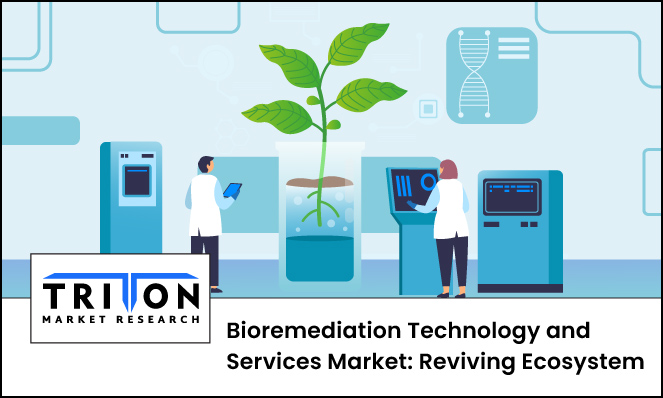



13, May 2024

As per the International Energy Agency, in 2022, global CO2 emissions from energy combustion and industrial processes increased by 0.9%, reaching a record high of 36.8 gigatonnes (Gt) .
Thus, a pivotal question emerges: What solution can effectively mitigate the environmental impact of industrial activities?
The alarming rise in emission levels has spurred a robust demand for bioremediation technologies and services. The bioremediation process uses natural organisms, primarily microbes, to break down hazardous substances into less toxic or non-toxic materials. It is an essential eco-friendly technology that harnesses the power of biological processes to mitigate environmental pollution. Accordingly, the Global Bioremediation Technology and Services Market is expected to advance at a CAGR of 7.97% during the 2024-2032 forecast period.
Explore in detail about this market in our FREE sample
From oil spill management to the restoration of urban brownfields, bioremediation techniques are being deployed worldwide to address a wide array of environmental issues. This widespread utilization underscores the versatility and effectiveness of bioremediation solutions in combating pollution, propelling the market forward.
Among the various services offered within the market, three have gained significant traction due to their critical importance and effectiveness:
Soil Remediation: As industrial contaminants increasingly compromise soil health, soil remediation has become a pivotal service. It involves various techniques to detoxify soils affected by chemical spills, industrial waste, and agricultural runoffs, thereby supporting ecological restoration and sustainable agriculture. Additionally, biochar can enhance bioremediation processes by providing a stable habitat for microbial communities that degrade pollutants. Its ability to improve soil properties, such as pH and moisture retention, further supports these microbial activities.
Recent advancements in bioremediation, particularly bioaugmentation for soil, have proven highly effective for degrading organic pollutants like petroleum hydrocarbons. This method not only reduces cleanup times but is also cost-effective. Its successful application across various contaminated sites highlights its versatility and efficiency in environmental restoration efforts.
Wastewater Remediation: This service is crucial for treating water bodies contaminated with industrial discharges, urban runoff, and sewage. The use of bioremediation processes in wastewater treatment helps in efficiently reducing pollutants, thus ensuring water safety and sustainability.
In one of its projects, Advanced BioTech employed BioWorld Liquid Optimizer and Hydrocarbon Digesting Microbes to oily wastewater in a tractor repair facility.
Oilfield Remediation: With the ongoing global reliance on fossil fuels, managing oil spillage and leaks is paramount. Bioremediation techniques used in oilfield remediation offer a potent solution for decomposing hydrocarbons, significantly minimizing environmental impacts.
Additionally, the use of microalgae in these processes not only supports the growth of oil-degrading bacteria but also directly engages in breaking down hydrocarbons through their metabolic processes. This dual role makes microalgae a promising tool in oil spill remediation, offering a more sustainable and less invasive alternative to traditional chemical methods.
Connect with our experts for a simplified analysis!
The Asia-Pacific bioremediation technologies and services market is anticipated to witness the fastest growth, expected to attain a CAGR of 8.65% during 2024-2032. This growth is primarily driven by rapid industrialization and heightened environmental regulations. Countries such as China and India are leading the way, with significant investments in bioremediation research and the implementation of large-scale remediation projects. For example, China's commitment to remediate urban industrial sites has catalyzed the adoption of advanced bioremediation solutions, making it a key player in the regional market.
Recent advancements in bioremediation technologies display innovative approaches to enhancing efficacy and application scopes. Notable developments include genetically engineered microbes with heightened capabilities to degrade specific pollutants and novel bioremediation products to tackle complex contaminations, including plastic waste. For instance, a recent breakthrough in 2023 involved the development of a microbial consortium capable of degrading polyethylene plastics, which constitute a significant portion of marine litter.
The bioremediation market is set to evolve with a focus on developing more targeted and efficient microbial agents, expanding the scope of pollutants that can be addressed. This progression will help tackle emerging contaminants while paving the way for more personalized and precise environmental remediation strategies.
Explore Our Latest Release for the 2024-2032 Market Analysis
Bioremediation is a process that uses natural organisms to break down hazardous substances into less toxic or non-toxic materials.
Q2) Why is bioremediation important?Bioremediation plays a critical role in managing environmental pollution by providing sustainable and effective methods to detoxify contaminated sites, thus helping to restore ecological balance and public health.
Q3) How does bioremediation help the environment?Bioremediation helps the environment by reducing pollution levels, rehabilitating contaminated ecosystems, and promoting the recycling of waste materials into beneficial compounds.

Prevalent cases of terrorist attacks in today’s world is increasing the need for severe standards of security for public safety, and the global market for biometric technology scrupulously accommoda..
Prevalent cases of terrorist attacks in today’s world is increasing the need for..